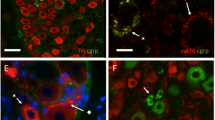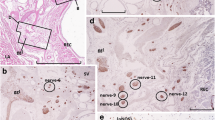Abstract
Pelvic ganglia are mixed sympathetic-parasympathetic ganglia and provide the majority of the autonomic innervation to the urogenital organs. Here we describe the structural and histochemical features of the major pelvic ganglion in the male mouse and compare two different mouse strains. The basic structural features of the ganglion are similar to those in the male rat. Almost all pelvic ganglion cells are monopolar and most are cholinergic. All contain either neuropeptide Y (NPY) or vasoactive intestinal peptide (VIP), or both peptides together. The peptide coexistence varies between strains, with C57BL/6 mice having similar proportions of neurons with NPY alone, VIP alone or both peptides. In contrast, virtually all pelvic neurons in the Quackenbush-Swiss (QS) strain express NPY, i.e. the level of VIP/NPY coexistence is much higher. Cholinergic axons provide the major nerve supply to epithelia of reproductive organs, bladder smooth muscle and, as described previously, penile erectile tissue. They also provide a minor component of the smooth muscle innervation of the prostate gland, seminal vesicles and vas deferens. Virtually all non-cholinergic pelvic ganglion cells are noradrenergic and contain NPY. Their major target is smooth muscle of reproductive organs. This study shows that the male mouse pelvic ganglion bears many similarities to that in the rat, but that VIP/NPY colocalisation is much more common in the mouse. We also show that there are differences in peptide expression in parasympathetic pelvic neurons between strains of mice. These studies provide the framework for future investigations on neural regulation of urogenital function, particularly in transgenic and knockout models.






Similar content being viewed by others
References
Baluk P (1995) Structure of autonomic ganglia. In: McLachlan EM (ed) Autonomic ganglia. Harwood Academic, London, pp 13–71
Corness J, Shi TJ, Xu ZQ, Brulet P, Hökfelt T (1996) Influence of leukemia inhibitory factor on galanin/GMAP and neuropeptide Y expression in mouse primary sensory neurons after axotomy. Exp Brain Res 112:79–88
Dail WG (1976) Histochemical and fine structural studies of SIF cells in the major pelvic ganglion of the rat. In: Eränkö O (ed) SIF cells: structure and function of the small, intensely fluorescent sympathetic cells. DHEW (NIH), pp 8–18
Dail WG, Evan AP, Eason HR (1975) The major ganglion in the pelvic plexus of the male rat: a histochemical and ultrastructural study. Cell Tissue Res 159:49–62
Dail WG, Moll MA, Weber K (1983) Localization of vasoactive intestinal polypeptide in penile erectile tissue and in the major pelvic ganglion of the rat. Neuroscience 10:1379–1386
Dail WG, Manzanares K, Moll MA, Minorsky N (1985) The hypogastric nerve innervates a population of penile neurons in the pelvic plexus. Neuroscience 16:1041–1046
Gibbins I (1991) Vasomotor, pilomotor and secretomotor neurons distinguished by size and neuropeptide content in superior cervical ganglia in mice. J Auton Nerv Syst 15:171–183
Green T, Dockray GJ (1988) Characterization of the peptidergic afferent innervation of the stomach in the rat, mouse and guinea-pig. Neuroscience 25:181–193
Guidry G, Landis SC (2000) Absence of cholinergic sympathetic innervation from limb muscle vasculature in rats and mice. Auton Neurosci 82:97–108
Holmberg K, Shi TJS, Albers KM, Davis BM, Hökfelt T (2001) Effect of peripheral nerve lesion and lumbar sympathectomy on peptide regulation in dorsal root ganglia in the NGF-overexpressing mouse. Exp Neurol 167:290–303
Iravani MM, Zar MA (1994) Neuropeptide Y in rat detrusor and its effect on nerve-mediated and acetylcholine-evoked contractions. Br J Pharmacol 113:95–102
Jobling P, Gibbins I (1999) Electrophysiological and morphological diversity of mouse sympathetic neurons. J Neurophysiol 82:2747–2764
Keast JR (1991) Patterns of co-existence of peptides and differences of nerve fibre types associated with noradrenergic and non-noradrenergic (putative cholinergic) neurons in the major pelvic ganglion of the male rat. Cell Tissue Res 266:405–415
Keast JR (1992) Location and peptide content of pelvic neurons supplying the muscle and lamina propria of the rat vas deferens. J Auton Nerv Sys 40:1–12
Keast JR (1995a) Visualization and immunohistochemical characterization of sympathetic and parasympathetic neurons in the male rat major pelvic ganglion. Neuroscience 66:655–662
Keast JR (1995b) Pelvic ganglia. In: McLachlan EM (ed) Autonomic ganglia. Harwood Academic, Luxembourg, pp 445–479
Keast JR (1999) Unusual autonomic neurons: chemistry, connections and plasticity of the pelvic ganglia. Int Rev Cytol 193:1–69
Keast JR, de Groat WC (1989) Immunohistochemical characterization of pelvic neurons which project to the bladder, colon, or penis in rats. J Comp Neurol 288:387–400
Keast JR, Booth AM, de Groat WC (1989) Distribution of neurons in the major pelvic ganglion of the rat which supply the bladder, colon or penis. Cell Tissue Res 256:105–112
Keast JR, Luckensmeyer GB, Schemann M (1995) All pelvic neurons in male rats contain synthetic enzymes for either noradrenaline or acetylcholine. Neurosci Lett 196:209–212
Kepper M, Keast JR (1995) Location, immunohistochemical properties and spinal connections of pelvic autonomic neurons which innervate the rat prostate gland. Cell Tissue Res 281:533–542
Kepper M, Keast JR (1997) Location, immunohistochemical features and spinal connections of autonomic neurons innervating the rat seminal vesicles. Biol Reprod 157:1164–1174
Kihara K, de Groat WC (1997) Sympathetic efferent pathways projecting bilaterally to the vas deferens in the rat. Anat Rec 248:291–299
Kihara H, Kakizaki H, de Groat WC (1996) Reorganization of the innervation of the vas deferens after sympathetic decentralization. Am J Physiol 271:R1481–R1488
Laurikainen A, Hiltunen JO, Thomas-Crussells J, Vanhatalo S, Arumäe U, Airaksinen MS, Klinge E, Saarma M (2000) Neurturin is a neurotrophic factor for penile parasympathetic neurons in adult rat. J Neurobiol 43:198–205
Luckensmeyer GB, Keast JR (1995) Immunohistochemical characterisation of sympathetic and parasympathetic pelvic neurons which project to the large intestine in the male rat. Cell Tissue Res 281:551–559
Luckensmeyer GB, Keast JR (1996) Immunohistochemical characterisation of viscerofugal neurons projecting to the inferior mesenteric and major pelvic ganglia in the male rat. J Auton Nerv Sys 61:6–16
Lundberg JM, Franco-Cereda A, Lacroix JS, Pernow J (1990) Neuropeptide Y and sympathetic neurotransmission. Ann N Y Acad Sci 611:792–802
Morris JL (1995) Peptides as neurotransmitters in vascular autonomic neurons. Clin Exp Pharmacol Physiol 22:792–802
Morris JL, Gibbins IL (1987) Neuronal colocalization of peptides, catecholamines, and catecholamine-synthesizing enzymes in guinea pig paracervical ganglia. J Neurosci 7:3117–3130
Morris JL, Gibbins IL (1992) In: Burnstock G, Hoyle CHV (eds) Autonomic neuroeffector mechanisms. Harwood Academic, Chur, Switzerland, pp 31–117
Mulryan K, Gitterman D, Lewis C, Vial C, Leckie B, Cobb A, Brown J, Conley E, Buell G, Pritchard C, Evans R (2000) Reduced vas deferens contraction and male infertility in mice lacking P2X1 receptors. Nature 403:86–89
Purinton PT, Fletcher TF, Bradley WE (1973) Gross and light microscopic features of the pelvic plexus in the rat. Anat Rec 175:697–706
Rogers H, Henderson G (1990) Activation of μ- and δ-opioid receptors present on the same nerve terminals depresses transmitter release in the mouse hypogastric ganglion. Br J Pharmacol 101:505–512
Rogers H, Kennedy C, Henderson G (1990) Characterization of the neurons of the mouse hypogastric ganglion: morphology and electrophysiology. J Auton Nerv Sys 29:255–270
Smith-White M, Hardy T, Brock J, Potter E (2001) Effects of a selective neuropeptide Y Y2 receptor antagonist, BIIE0246, on Y2 receptors at peripheral neuroeffector junctions. Br J Pharmacol 132:861–868
Steers WD, Mallory B, de Groat WC (1988) Electrophysiological study of neural activity in penile nerve of the rat. Am J Physiol 254:R989–R1000
Steers WD, Ciambotti J, Erdman S, de Groat WC (1990) Morphological plasticity in efferent pathways to the urinary bladder of the rat following urethral obstruction. J Neurosci 10:1943–1951
Tabatabai M, Booth AM, de Groat WC (1986) Morphological and electrophysiological properties of pelvic ganglion cells in the rat. Brain Res 382:61–70
Trendelenburg A, Klebroff W, Hein L, Starke K (2001) A study of presynaptic alpha2-autoreceptors in alpha2A/D-, alpha2B- and alpha2C-adrenoceptor-deficient mice. Naunyn Schmiedebergs Arch Pharmacol 364:117–130
Vlaskovska M, Kasakov L, Rong W, Bodin P, Bardini M, Cockayne D, Ford A, Burnstock G (2001) P2X3 knock-out mice reveal a major sensory role for urothelially released ATP. J Neurosci 21:5670–5677
Acknowledgements
We thank Michael Schemann and Robert Rush for generous provision of antisera.
Author information
Authors and Affiliations
Corresponding author
Additional information
Grant sponsors for this study were the National Health and Medical Research Council (Australia), grant no. 000044; the Australian Research Council, grant no. A00104654; and the Spinal Research Foundation
Rights and permissions
About this article
Cite this article
Wanigasekara, Y., Kepper, M.E. & Keast, J.R. Immunohistochemical characterisation of pelvic autonomic ganglia in male mice. Cell Tissue Res 311, 175–185 (2003). https://doi.org/10.1007/s00441-002-0673-1
Received:
Accepted:
Published:
Issue Date:
DOI: https://doi.org/10.1007/s00441-002-0673-1




